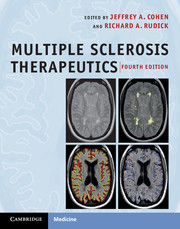Book contents
- Multiple Sclerosis Therapeutics
- Multiple Sclerosis Therapeutics
- Copyright page
- Contents
- Contributors
- Abbreviations list
- Foreword
- Preface
- Section I Introduction
- Section II Clinical trial methodology
- Section III Clinical trials of multiple sclerosis therapies
- Section IV Therapy in clinical practice
- 51 Disease-modifying therapy for multiple sclerosis in clinical practice
- 52 Treatment for patients with primary progressive multiple sclerosis
- 53 Diagnosis, pathogenesis, and treatment of neuromyelitis optica (NMO) spectrum disorders
- Chapter 54 Management of pediatric multiple sclerosis
- 55 Use of MRI in the clinical management of multiple sclerosis
- 56 Multiple sclerosis-associated fatigue
- 57 Management of spasticity
- 58 Management of bladder and sexual dysfunction in multiple sclerosis
- 59 Depression in multiple sclerosis
- 60 Assessment and treatment of pain disorders in multiple sclerosis
- 61 Management of medical comorbidities in patients with multiple sclerosis
- 62 Rehabilitation in multiple sclerosis
- Index
- Plate Section
Chapter 54 - Management of pediatric multiple sclerosis
from Section IV - Therapy in clinical practice
Published online by Cambridge University Press: 05 December 2011
- Multiple Sclerosis Therapeutics
- Multiple Sclerosis Therapeutics
- Copyright page
- Contents
- Contributors
- Abbreviations list
- Foreword
- Preface
- Section I Introduction
- Section II Clinical trial methodology
- Section III Clinical trials of multiple sclerosis therapies
- Section IV Therapy in clinical practice
- 51 Disease-modifying therapy for multiple sclerosis in clinical practice
- 52 Treatment for patients with primary progressive multiple sclerosis
- 53 Diagnosis, pathogenesis, and treatment of neuromyelitis optica (NMO) spectrum disorders
- Chapter 54 Management of pediatric multiple sclerosis
- 55 Use of MRI in the clinical management of multiple sclerosis
- 56 Multiple sclerosis-associated fatigue
- 57 Management of spasticity
- 58 Management of bladder and sexual dysfunction in multiple sclerosis
- 59 Depression in multiple sclerosis
- 60 Assessment and treatment of pain disorders in multiple sclerosis
- 61 Management of medical comorbidities in patients with multiple sclerosis
- 62 Rehabilitation in multiple sclerosis
- Index
- Plate Section
Summary
Keywords
- Type
- Chapter
- Information
- Multiple Sclerosis Therapeutics , pp. 632 - 644Publisher: Cambridge University PressPrint publication year: 2011



